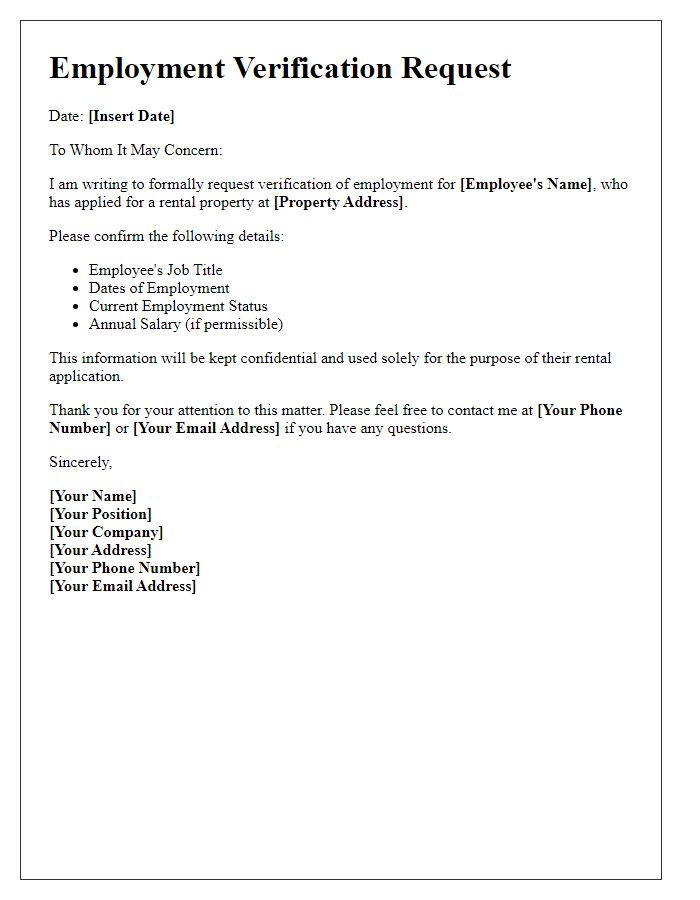Are you in need of a simple yet effective way to request an employment verification? Whether you're a landlord, lender, or an organization needing to confirm someone's job status, having a concise letter template can make the process smooth and professional. In this article, we'll walk you through the essential elements of an employment verification request letter, ensuring you cover all bases. So, let's dive in and explore how to create a request that gets results!

Recipient's Contact Information
An employment verification request should include specific details to ensure clarity and accuracy. The recipient's contact information typically encompasses elements such as the recipient's name, job title, and organization, followed by the complete mailing address including street name, city, state, and ZIP code. Additionally, it can include relevant contact numbers such as phone and fax, as well as an email address to facilitate prompt communication. Ensuring that this information is up-to-date and correct is crucial in streamlining the verification process and fostering effective correspondence between all parties involved.
Requester's Contact Information
Employment verification requests are essential for confirming an individual's employment history and details. Providing accurate requester's contact information is crucial for facilitating swift communication. Essential elements include the requester's full name, which identifies the individual requesting the verification, their phone number (often in format like (555) 123-4567) for direct contact, and an email address (e.g., requester@example.com) that serves as an additional communication channel. Additionally, including a mailing address, such as 123 Main Street, City, State, Zip Code, can be valuable for sending any required documentation. Timely and clear communication ensures efficient processing of the employment verification request.
Employee's Full Name and Employment Details
An employment verification request typically seeks to confirm specific details about an employee's work history and status. The request must include the employee's full name, job title, dates of employment, and the company name. Verification can include confirmation of salary, job responsibilities, and employment status (full-time or part-time). Often, this process is crucial for securing loans, leasing agreements, or new job opportunities. Additionally, the request should specify the reason for verification and provide contact information for follow-up, highlighting the importance of accurate and timely verification in professional contexts.
Purpose of Verification
Employment verification serves multiple purposes, crucial for both the employee and the employer. It establishes the authenticity of an individual's work history, ensuring that details such as job title, duration of employment, and compensation are accurate. This process is often utilized during background checks for new positions, where companies like XYZ Corporation or ABC Enterprises might request information to assess a candidate's qualifications. Furthermore, lenders may require employment verification to confirm income stability when applying for loans or mortgages, such as those through the Federal Housing Administration (FHA) or private institutions. Additionally, verification aids legal processes, providing evidence in disputes over employment issues or claims of benefits. Employers may use reliable verification sources, which could include third-party services, ensuring a standardized approach to gathering necessary employment details.
Authorization and Signature
An employment verification request typically requires essential details such as the employee's full name, position, dates of employment, and the specific purpose of verification. This request often includes a section for the employee's signature along with a date to authorize the release of information. Authorization serves as legal consent, protecting both the employer and the requestor while ensuring compliance with privacy regulations. The verification may need to be sent to lenders, leasing companies, or background check services, highlighting the importance of accurate information and timely processing. Clear identification of the requesting party and their relationship to the employee often enhances the validity of the request.
Letter Template For Employment Verification Request Samples
Letter template of employment verification request for mortgage application

Letter template of employment verification request for car loan approval

Letter template of employment verification request for rental application

Letter template of employment verification request for social security benefits

Letter template of employment verification request for immigration purposes

Letter template of employment verification request for credit card application

Letter template of employment verification request for student loan processing

Letter template of employment verification request for professional licensing






Comments